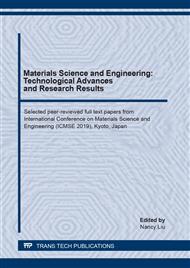p.3
p.10
p.18
p.24
p.31
p.39
p.47
p.57
Friction Characteristics of Surface Nitriding Modification Layer of Ti-6Al-4V ELI Titanium Alloy in Seawater Environment
Abstract:
In order to study the tribological properties of titanium alloy materials and reinforced PTFE pairs treated by surface nitriding modification in seawater environment under low speed and high load, the physical properties of surface nitriding modified treatment were observed and measured with Ti-6Al-4V ELI as the substrate, and the samples of substrate and surface nitriding were modified as disks to 25% fiberglass , 15% glass fiber +5% graphite and 60% tin bronze reinforced PTFE as distribution pins, the friction properties of substrate and surface nitriding modification layer in seawater environment were studied by friction tester. The results show that the friction coefficient between titanium alloy and auxiliary pair is above 0.1, the friction coefficient of titanium alloy surface treatment specimen is lower than that of TC4 titanium alloy, the wear of surface nitriding modified treatment sample is significantly slight, the friction coefficient of 60% tin bronze distribution is the highest, and the friction coefficient of 15% fiberglass +5% graphite is about 15% higher.
Info:
Periodical:
Pages:
18-23
Citation:
Online since:
August 2020
Authors:
Price:
Сopyright:
© 2020 Trans Tech Publications Ltd. All Rights Reserved
Share:
Citation:


